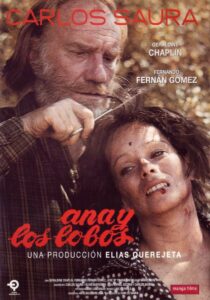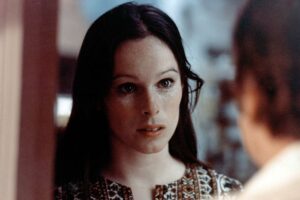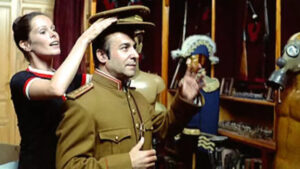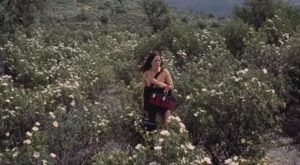“Anna and the Wolves” – a Woman on the Altar of Male Power

Title: “Anna and the Wolves” (“Ana y los lobos”)
Release Date: 1972
Director: Carlos Saura
Cast: Geraldine Chaplin, Rafaela Aparicio, Fernando Fernan Gomez, Jose Maria Prada, Charo Soriano, Jose Vivo, etc.
The role of Anna in Carlos Saura’s acclaimed film is one of Geraldine Chaplin’s best performances. She created a highly evocative character of a young woman who retains credibility both as a real person and as an allegory of Spain and womanhood.
“Anna and the Wolves” – Saura’s 1973 film is one of the links of a larger cycle dealing with social and national issues. Due to the Francoist censorship in force at the time, the filmmaker used allegorical language. Today, when the political context is no longer relevant, the film has not lost its value. Saura’s picture still makes a great impression, especially as a statement on women and their place in the patriarchal order.
The titular Anna is a young Englishwoman who arrives in the Spanish countryside to work as a governess in a respectable family with traditions. The huge house is inhabited by the mother (Rafaela Aparicio), the senior of the family, and her three adult sons. Jose (Jose Maria Prada) manages the whole estate, Juan (Jose Vivo) is the father of three girls whom Anna has to take care of, and Fernando (Fernando Fernan Gomez) is a bigot who spends his days in a cave where he prays and meditates. Almost immediately, the protagonist becomes entangled in complicated relationships with three men. Juan, despite having a family, is an erotomaniac who tries to seduce Anna and writes her obscene letters. Jose is a passionate collector of militaria and enlists her help in their preservation, while enjoying the power over the entire household. Fernando, on the other hand, wants to convert Anna and save her soul.

The heroine takes up a perverse game – under the guise of accepting the brothers’ eccentricities, she leads to their unmasking and ridicule. And so: Juan, declaring great love for Anna, eventually cowards out of fear of his wife, Jose’s peak of courage turns out to be shooting a colorful bird, and Fernando is not a praying monk, but a fetishist who wants to strip the girl of her hair. Anna, unaware of the danger, joyfully leaves the insane house ruled by her despotic mother, but on her way to the station she is attacked by her brothers, raped, disfigured, and finally murdered.
“Anna and the Wolves” – the great allegory
“Anna and the Wolves” is commonly read according to an allegorical key. The house (Carlos Saura’s characteristic metaphor of imprisonment) is a figure of the whole country, the elder of the family is its traditional face, while the three brothers (the wolves of the title) represent the three most powerful forces wielding power in Spain: the regime state, the Church, and the socially accepted macho cult. The men’s rivalry over Anna is in turn an allusion to the Spanish Civil War of 1936. The protagonist also brings to mind Spain, but a modern Spain, free from the burdens of the past, which becomes the object of attack by the guardians of the authoritarian order.
The allegorical sense of “Anna and the Wolves” clearly draws on biblical traditions, folk tales and Spanish painting. Saura refers to the legend of the she-wolf and her bloodthirsty sons, the werewolves. One of them depicts a white mare (an allegory of Spain) being torn apart by wolves. In another, the painter has placed a figure of a naked, dead woman (also an allegory of Spain), who is ominously watched by terrifying figures.

Saura’s film also evokes a circle of biblical meanings. If the brothers are wolves, Anna becomes a helpless sheep. Furthermore, her murder is clearly ritualistic, and is foreshadowed by Fernando’s burying of the little nieces’ doll. Anna’s death thus functions in the film much like Christ’s death in the Bible – prefigured by the sacrifice of Isaac, replaced at the last moment by a lamb.
“Anna and the Wolves” – in the footsteps of Freud – childhood is the key to adulthood
The protagonist of Saura’s film is the Other in a world closed and sanctified by tradition. It is no coincidence that Anna is English – because only someone from the outside can take a detached look at the hermetic Spanish reality and reveal its paradoxes. The girl unerringly deciphers the hidden reasons behind the brothers’ bizarre behavior.
Jose, for example, was disguised as a girl as a child, so now he wants to prove his masculinity at all costs through cruelty and control over others. Fernando, on the other hand, is a victim of the sadistic method of teaching thumb-sucking with a thimble filled with sharp spikes. Therefore, in his adult life he finds fulfillment in masochistic practices of mortifying the body under the pretext of deep religiousness (in the subtext, of course, lurks the stigma of the Spanish Invasion). In a parabolic way, Carlos Saura exposes the hypocrisy of the regime’s power and authoritarian religion, whose ideals are often used to conceal not-so-high motives.

“Anna and the Wolves” – woman as ritual sacrifice
The most interesting element of the film, however, is the way in which Anna assumes the role of scapegoat who is blamed for the unexpected eruption of evil. It is worth noting that Anna’s murder has a highly symbolic dimension – Juan rapes Anna, Fernadno cuts off her hair, and Jose kills her with a shot to the head. This tragic situation reflects the position of women in the patriarchal order. For a macho culture, women are above all sexual objects, and therefore constantly exposed to exploitation and sexual violence.
The Church, on the other hand, presents femininity in terms of moral guilt (Eve – the primordial mother of sin) and stigmatizes its carnal attributes. Cutting off her hair is a symbolic deprivation of Anna’s erotic attractiveness, as well as an expression of humiliation and blaming the girl for the rape. Jose’s shooting of the protagonist can be interpreted as the execution of a sentence and a total takeover of a defenseless woman by a military state. The dead Anna becomes a helpless object in the hands of the three brothers – she is deprived of her own will and subjectivity. Only in this form does she become the fulfillment of a sadistic dream. What is more, this fulfillment is absolved – according to the logic of the extremely patriarchal order – Anna is guilty of herself, and even justly punished for unmasking and mocking her brothers’ innermost desires, thus violating the sacred order that has existed for centuries.
E. Królikowska, “Śladami Buñuela. Kino hiszpańskie”, Warszawa 1988.
